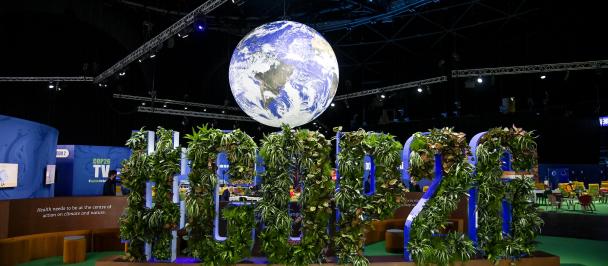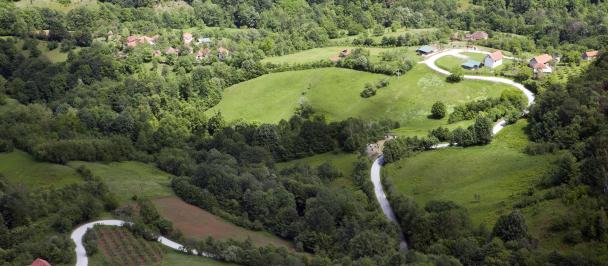Photo: Vladimir Živojinović for UNDP
While the heated debates of the Glasgow climate conference have cooled down, our climate keeps heating up. The world’s chance of holding global temperature increase to 1.5C above pre-industrial levels is at stake. The ravages of climate breakdown could become catastrophic, and some are already irreversible.
In Glasgow the world made progress on the 3 objectives set at the start of COP26: 1. countries increased their commitments to cut greenhouse gas emissions (GHG) to keep within the reach the global warming limit of 1.5°C; 2. developed countries pledged to reach the target of $100 billion per year of climate finance to developing and vulnerable countries, and 3.developed countries also agreed to pay equal attention to climate change adaptation, both in financial and policy planning terms, by 2025. Finally, CoP26 resulted in the adoption of “The Glasgow Climate Pact”- a roadmap for countries for reaching the Paris targets.
Glasgow’s milestone resolutions on reduction of methane and forest and land preservation set the foundation for strong and fast climate action. Over 100 countries representing 70% of the global economy, led by the USA and the EU, committed to reduce methane emissions by 30% by 2030, while more than 140 countries pledged to end deforestation in the same period. It is commendable that Serbia joined both of these important pledges.
COP26 gave us hope and confidence that we can provide a safe and prosperous space for humanity on this planet. But there is no time to relax: hard work is still ahead.
It will encompass accelerating efforts towards the phase-down of unabated coal power and inefficient fossil fuel subsidies and recognising the need for support towards a just transition for people currently working in fossil-fuel related industries such as the car and steel industries, or cement or electricity production. Countries will also have to play a transparent and fair game in reporting against the national GHG emission reduction targets. The Glasgow Climate Pact commits 197 signatories to report their progress towards more climate ambition next year, at COP27 in Egypt.
Zooming in to Serbia
At COP26, Serbia expressed a valid concern about the financing for a green transition, safeguarding energy security and supporting workers to switch to green jobs and industries.
The good news is that the financing is there. However, for “green financing” to make sense, it requires increasing the climate ambition. The climate ambition of each country is reflected in nationally determined contributions (NDCs) - plans containing targets on emissions cuts and adaptation, usually by 2030, and how they will be met. Adoption of revised NDCs, which Serbia announced prior to the COP26 - is the best way to ensure access, not only to various environment and climate change global funds and bilateral grants, but also to favourable green loans and other borrowings.
Serbia’s robust economic growth and significant investments in infrastructure are evident. However, to maintain and bring new growth, deep decarbonization and a green transformation is needed, particularly if we have in mind the country’s key export market – the EU, where consumers are already favoring goods with a low carbon footprint.
In Serbia, energy sector holds the key to a climate neutral economy and society. Increasing energy efficiency and using more renewable energy in the economy (including buildings, transport sector and industries) are the main vehicles for a clean energy transition, as it will not only create energy savings, but also reduce emissions and air pollution.
Currently Serbia spends 3 times more energy per GDP unit than the EU average. Increasing energy efficiency in public buildings by only 10% would remove the need for 1 older thermal power plant. Serbia could increase the efficient use of energy by renovating public and private buildings and by helping enterprises in Serbia spend less energy in their production process.
Adapting to new climate reality
In parallel, we need to start working together on adapting to an already changed climate. Serbia and South Eastern Europe are heating up faster than the global average. This region will be strongly affected by climate change. Children born today may well experience the dramatic effects of intensified floods, wildfires, droughts and harsh economic impacts. Farmers will lose incomes, roads and railways could be heavily affected. Through it all, the cost of not acting will be higher than the cost of acting. Serbia could face $13 million in losses and damages by the end of this decade.
To ensure resilience of the economy and society, we need to focus on irrigation, water management and tackling droughts. UNDP reports indicate that, without irrigation measures, maize yields are expected to decrease up to 58% and wheat yield will decrease as much as 16% by 2030. Small agricultural producers and seasonal workers would be hit the hardest. The entire population would be impacted through reduced availability of food, and the possible rise in food prices.
To have enough water supplies for food production and energy generation, Serbia needs more resilient types of crops, water storage systems (such as dams and water reservoirs), as well as drainage systems. Building wastewater treatment facilities would reduce organic pollution of watercourses and lakes and maintain their viability under increased temperatures and expected water shortages.
Also, numerous small-scale innovative solutions are becoming increasingly affordable and easily deployable to help Serbian farmers adapt. For example, Serbian scientists at the Institute Mihajlo Pupin have developed innovative technology to ensure resource-efficient and climate resilient farming.
The EU and UNDP encourage further investments into innovative technologies and businesses and the transfer of innovative technologies to Serbia - to reduce GHG emissions, strengthen community resilience to the impacts of climate change and create green jobs.
Financial infusion for green transformation
To kick-start the green transformation, the EU has prepared The Green Agenda for the Western Balkans, as part of the EU’s Economic and Investment Plan. The Western Balkans economies have endorsed it fully, and recently adopted its regional Action Plan. The Agenda tackles 5 broad areas covered by the Green Deal: decarbonisation, depollution of air, water and soil, circular economy, farming and food production, and protecting biodiversity.
The EU and UNDP intend to start a 2-year initiative in 2022, in cooperation with the Swedish International Development Cooperation Agency (SIDA) and European Investment Bank. It will help Serbia precisely in these areas, to improve policies, take concrete actions and scale-up investments for green transformation. Through IPA 2020 programme, the EU and Serbia have earmarked €8M to abate air pollution, fight against biodiversity loss and support businesses to become more circular. One part of this support will fund scaling up of green projects. We welcome other donors, banks, and development partners to join us in implementation of the Green Agenda in Serbia.
Besides contributing to decarbonization of the economy, we hope that this initiative will trigger a small green industrial revolution in Serbia, run by national and local governments, industries, public and private companies, as well as CSOs. It will also accelerate harmonization with EU standards and norms.
Many people in Serbia have become increasingly concerned about the environment. The EU has the strictest environmental legislation in the world. When well enforced, it allows to decrease air pollution and emissions, and provide clean water, while creating jobs and growth. We believe that strict enforcement and full implementation of the respective EU legislation transposed in Serbian law will also help to improve environmental protection in Serbia.
Despite the undeniable health and environmental benefits of a green transition, recent global energy shortages and rising gas prices have given rise to the question whether it is too risky and costly to abandon fossil fuels. On the contrary, such crises should make us turn to renewables and green solutions even faster. One of the key takeaways from the COP 26 is that financing of clean energy will only become cheaper, while financing of fossil fuels will be increasingly expensive.
In the long run it is simply smarter to go green. In parallel, it’s the only way to go, for the people, the economy and the planet. A lot is at stake.
Text originally published in Vreme weekly.

 Locations
Locations

